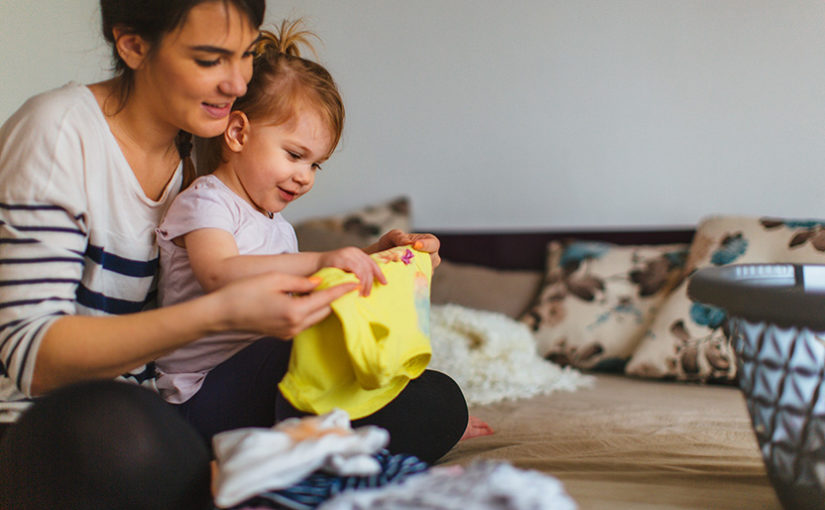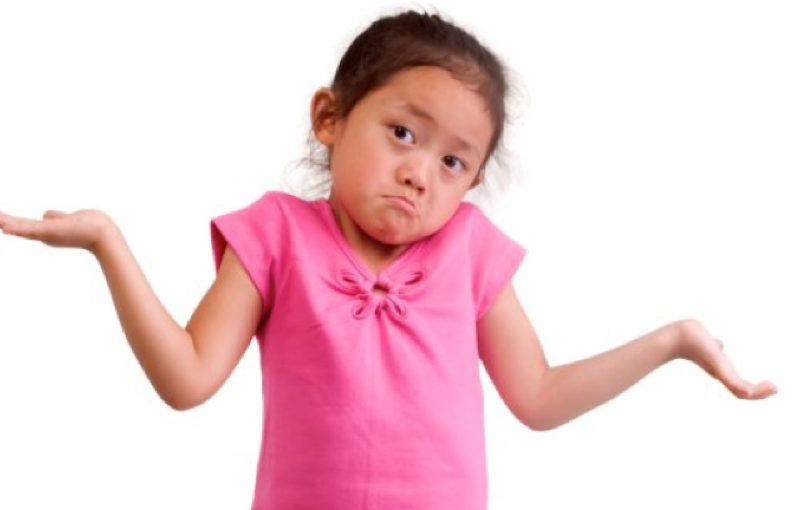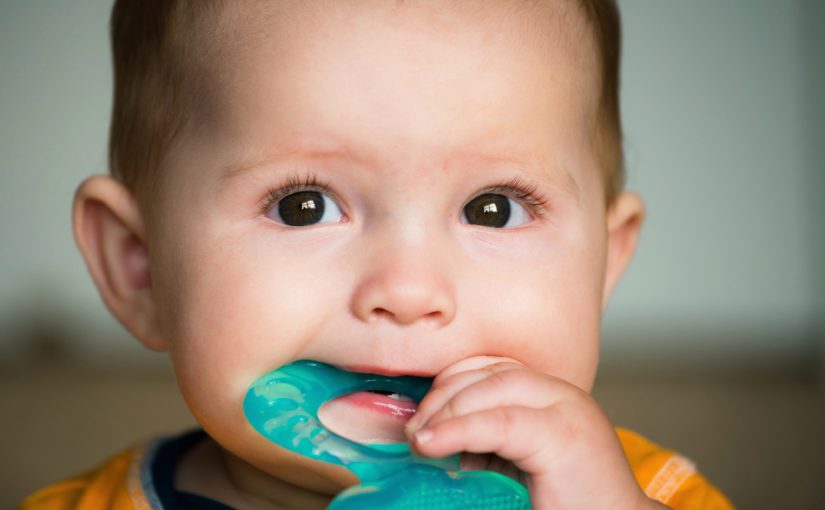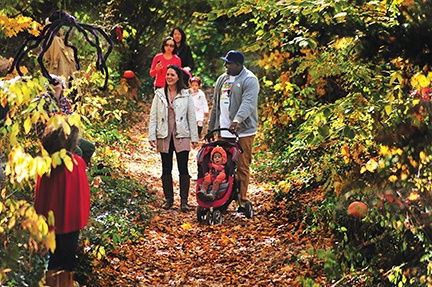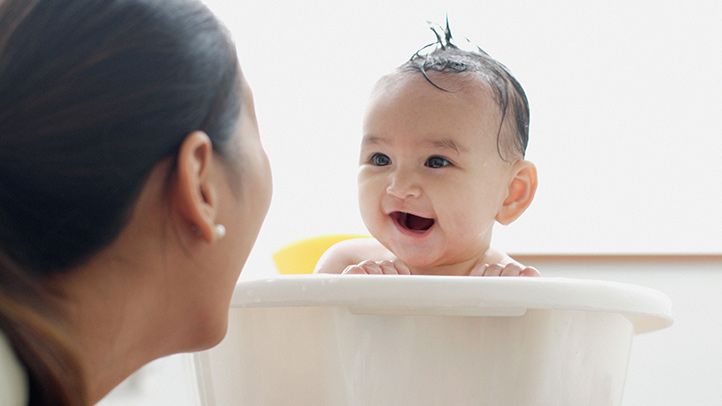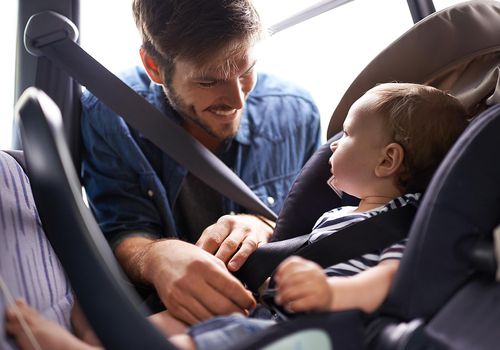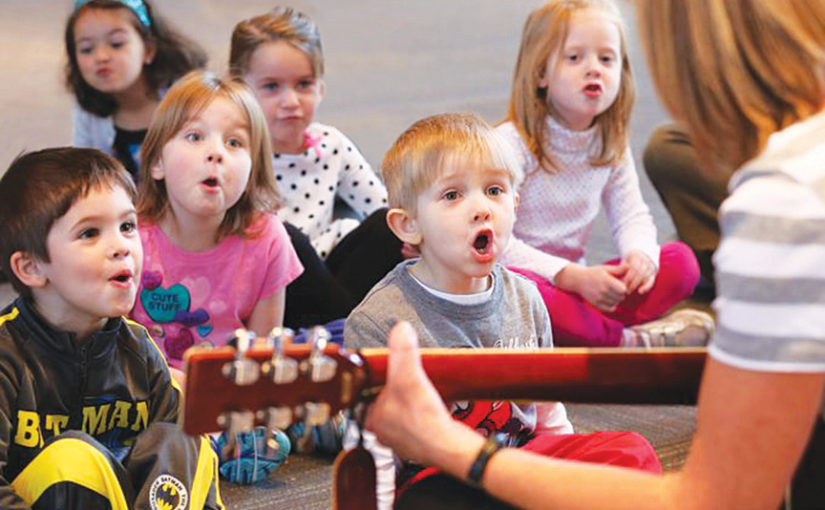Category: Talk
LET’S DO LAUNDRY!
Laundry. One of my least favorite chores. It has to be done though so why not make it a learning experience while you get the kiddos to help! While it may make the process twice as long, your young children can build vocabulary as you name the clothing you are putting in the washer or dryer, or as you’re folding. If they are helping to load, you can also expand to model word combinations(Pants in! or Go in!). When the clothes are dry, even small children can follow directions to find certain items, learning to sort(All the socks go here). When they begin to match, they can match all the socks for you! You can also attach possession to clothing and help them learn “my” vs “your” or “Daddy’s and Mommy’s”. Labeling colors is also a great way to expand on naming the clothing as they get closer to preschool(Blue shirt). This monotonous activity can be such a great natural learning experience, and they are helping you with chores!
Words/Sounds to include: shirt, pants, socks, shorts, underwear, in, out, wet, dry, my, your, colors, etc.
YES OR NO?
If you are a parent/caregiver of a toddler, you already know the majority of your day is spent teaching them there are limits to set for their curious minds! Often the word “no” occurs more than we would like sometimes. When your child begins to use it, it can be overwhelming to teach them whin it is o.k. to use it and when it’s not. Sometimes, children say “no” when they actually mean “yes”. Not only is the word an easier sound combination for some children, but Although hearing “no” from your toddler all day long can be difficult, it is important to remember “no” is an essential word! We have to use it to answer questions and to make choices/decisions all the time. There are many ways to help your child learn to answer “yes” or “no” accurately. For children who are experiencing difficulty expressing themselves, it can be one of the most helpful ways for them to communicate with others. The following are examples to help your child learn to respond “yes” or “no” accurately:
“YES”
Adult: Do you want cheerios or crackers?
Child: Gestures toward cheerios(with or without verbalizing
Adult: You want cheerios?*
Child: Imitates nodding head and makes attempt to imitate the word
*Hold the cheerios up to your face while nodding “yes” before giving them the cheerios while modeling “yes”*
“NO”
Adult: I found your boat!(Playing in the bathtub) Does it go up in the sky?
Child: Giggles or gets frustrated
Adult: No, that’s silly!(Try it in a silly voice while shaking your head)
Child: Laughs and imitate “no”
*Plop it in the water to play*
These strategies can work in almost every routine and activity we engage in with our children! If you have any questions, feel free to message me!
*Important to remember: Give your child time to respond to questions depending on their level of frustration in the moment. Typically it is recommended 3-5 seconds of wait time.*
WHY DOES EVERYTHING GO IN THEIR MOUTHS?
As parents, we want what is best for our babies. We want to make sure they are safe, they are healthy, and what goes in their mouths is clean. As soon as they are able to pick up, grasp, and move their hands to their mouths, they will put things in there😊. Inevitably, we then have to make sure it’s not something they will potentially choke on or get sick from. Babies can begin teething as early as 4 months! Although we don’t want them to put EVERYTHING in their mouths, this is a developmental stage and important for both feeding and speech development. As you begin to notice their hands going in their mouths more often, they will begin to try other objects as well, sometimes even your fingers or hands! This is when we as parents, can provide them objects that are appropriate. In this day and age, we can easily look for objects to provide them at a click of a button. Many toys you may already have for them could have different textures on parts of them just for teething so definitely check it out. Let them explore(safely)! As they put things in their mouths, they are learning a hand to mouth connection, important for feeding development. In addition, this gives them the opportunity to build awareness of the structures in their mouths, how they can move them, and different sounds they can produce with these movements. It also helps with the pain of teething and break those teeth through the gums. So, before you take that toy they just put in their mouth out, assess if it’s safe, clean, and appropriate. If it is, let them keep exploring!
*If your baby isn’t going through this stage, struggling with feeding, and not beginning to make more sounds, contact your pediatrician to inquire about you local Early Intervention program.
**Nobody Evert Told Me(or My Mother) That! By: Diane Bahr
UNDERSTANDING HOW WE UNDERSTAND
What is receptive language? Although it means our understanding of language, it is not commonly understood among parents/caregivers. Most of the time the focus is on expressive language, which is how we use language. One of the top questions on the questionnaires we as parents/caregivers fill out during regular pediatrician visits is “How many words is your child saying?”. However, almost more importantly, we should know what our child is understanding! We can attach labels to everything our children see or experience in their environment very early on! From the time they are tiny, we are talking to them; during feedings, diaper changes, and play. This is how they begin to learn that everything has a name! As they begin to sit supported or independently, you can help them learn through all of their senses, then helping them to touch or eventually point to objects/pictures as you name them. Then they begin to walk and you can begin to give simple directions, as well as, make sure they respond to their names. For example, “Joey, get your cup.”. You will also most likely need to point at first to show them where it is or walk with them to show them to pick it up. As you praise them for following through, they will begin to learn names of objects they use or need on a regular basis, as well as, action words. Soon, they will begin to respond to “Where is Daddy?” by waddling over, or remembering where they put their favorite toy as you wonder out loud, “Where did that ball go?”, finding it for you! You can eventually begin to include them in some simple household chores, such as telling them to take out all the socks in the laundry basket for you😊. Children learn best from their parents/caregivers through every day routines/activities. Start early talking to them and they will show you early on how much they take in!
TAKE A WALK!
Over the last few months, we have all been spending time outside with our families even more often than before. With Summer ending and Fall right around the corner, Winter will be here before we know it! Let’s get out and take a walk! Whether your kiddo is in a stroller, wagon, or walking with you, this is a great opportunity to teach them new words. Think of all the things they can see and touch outdoors. Label what you see while pointing to it or even helping your child feel all the different textures. For example, “Look a flower!” or “There’s a tree!”. When they are a little older, you can add some descriptive words as well. “The grass is green”, “The plane flies high up in the sky”, “Splash in the puddle”, “All wet!”. Encourage your child to feel the bark on the tree and how rough it is, then how soft the grass is or even the dog you may see! If you have multiple children, make your walk a game so they can find certain objects you tell them to, like an “I spy” game. When your child spots what you asked them to find, model “I see the….” for them to imitate. This builds on the words they may be using to label the objects as a natural expansion. There are so many bright colors right now to point out and describe. Soon, we will be describing all the beautiful Fall colors and the “Fall” objects we will be seeing. Children learn new words so quickly as adults around them teach during regular routines and activities. Let’s take advantage of the outdoors as long as we can to have fun engaging with our children while teaching them in a fun way. Plus, we all get some exercise which will help everyone feel good while soaking up all kinds of information!
Sound/words to include: trees, grass, flowers, birds, bees, butterflies, leaves, house, sun, sky, clouds, rain, snow, hot, cold, wet, dry, big, little, up, down, colors, car, truck, bus, plane, bike, train, vroom, beep, zoom, choo choo, stop, go, names of animals and their sounds, hi, bye, etc.
BATH TIME!
Bath time! It’s one of the first routines we engage our babies in. Even when they are tiny, we teach our young children a lot during this regular routine. Babies are learning about how different textures feel-the water temperature, the feel of the wash cloth, what soap feels like. Some babies love the water, some do not. Talking them through the process of bath time can engage them to learn and distract them if they feel distress. Incorporate some singing during the routine and it will help ease not only your child’s stress but your own as well! Explain what is happening when they are little, ask them questions as they get older about the process. For example, “We turn the water on”, “Brrrr it’s cold!”, “Let’s make it nice and warm.”, “We get some soap for the washcloth and scrub your belly, your arms, now your…..”. Keep going as you name each body part. When they are older, play a game and ask them “Where’s your nose?”, “Where’s Mommy’s nose?”, “Beep, there it is!”. This is a good way to learn body parts. Not only are they in the tub and it’s a little more difficult to move to another activity, but the acoustics in the bathtub are beneficial for children to learn speech and language. Talk about the toys they may play with by labeling them and describing what the toy is doing. This is also a good time to give choices as they play and take turns with the toys with you. For example, “Do you want the boat or the duck?”. Wait for your child to either use the word to ask for it or gesture toward the choice. If you can, hold the toy close to your mouth as you model the word and cue them to try to imitate it. Also, make sounds while playing or even silly faces for your child to eventually imitate. Receptive language skills can also be built during this routine. Provide them simple directions during play, such “Give Daddy the duck please”, or “Put the boat in the water”. The bathtub provides a great opportunity to have fun while your baby learns to communicate with you!
Sounds/words to include: water, soap, washcloth, towel, bubbles, on, off, hot, cold, wet, dry, in, out, splash, plop, dump, pop, names of body parts, names of toys, etc.
RIDING IN THE CAR
Ever wondered how much children can learn while riding in the car? Whether your child is rear facing or forward facing, it can be possible to learn new fun things during car rides, long or short! Some children love car rides, some do not. For those who don’t like it so much, we can find ways to distract them from their protest by utilizing language! As you are getting them in the car, describe what you are doing, maybe even by singing it. For example, “Up, up, up we go”, “For a ride we go”(tune of Row, Row, Row Your Boat), “For a ride”, “In the car”, “For a ride we go”. Talk to them about getting their arms in the straps(Arms in, 1, 2), buckling it up(Snap!), then “Here we go!”. When able, talk about what you see during the ride, sing some songs(especially for the riders that don’t enjoy it so much). For the forward facing riders, ask them questions about what they see or hear so they can tell you. If you’re not the driver, maybe even offer some choices of drinks or snacks, which is also a good way to keep them distracted from any anxiety they may feel. Use a lot of descriptive language as you talk about what you see. For example, “Look!” “A big truck!”, “There’s a blue car”, “Awwww what a cute puppy!”, “There’s a cow, what does it say?”, “Mooooo, that’s what a cow says!”. Even if they aren’t able to, or choose not to repeat sounds/words back to you, they are still absorbing the information and will eventually engage in imitation. Most importantly, have fun with them and enjoy the time without having to worry about the regular interruptions of life!
Sounds/words to include: car, seat, sit, up, down, in, out, go, stop, buckle, snap, truck, plane, house, trees, sun, clouds, stars, moon, sky, beep, zoom, slow, fast, name animals you might see, colors, foods/drinks you may have, etc.
MUSIC MAKES THE WORLD GO ‘ROUND
Music is a universal language. Most children at a very young age respond to, engage, and interact with music. It can be used to get children to move or to help soothe/calm them when they are upset. Music makes us feel many emotions. We can also use it to teach our children sounds and words! Whether it’s popular music you hear on the radio or familiar children’s songs, it can be a fun way to teach them to imitate or anticipate to fill in sounds and words. Some common children’s songs that can often be heard at schools or child care settings are: Wheels on the Bus, Old McDonald, Isty Bitsy Spider, Twinkle, Twinkle Little Star, Row, Row, Row You Boat, Happy and You Know It, Head, Shoulders, Knees, and Toes, ABCs, and the now very popular Baby Shark. Many of these songs also pair actions to the words. Most children will imitate actions first, then begin to pair a sound/word/word approximation with the action. Children who are less vocal/verbal will gain confidence with action imitation and once they feel able to imitate the sound/word, will do so without even realizing it. For some children, the motor actions are enough of a distraction from speech being difficult for them that they eventually begin to make sounds. As parents/caregivers, we can build their engagement and interaction while singing songs with them by pausing at the end of a phrase or certain part of the song. This will give them the opportunity to try to fill in the pause. For example, while singing “Itsy Bitsy Spider”, pause before saying “down” to start with. Your hands will already be up ready to show them the gesture of “Down came the rain” so they will have the visual cue of what is coming next in the song. During “Old McDonald” or “Baby Shark”, give them the opportunity to decide who(animal or person) comes next. First ask “Who’s next?” to see if they can suggest, or give them a choice if they aren’t able to. For example, sing “Old McDonald had a farm, E-I-E-I-O” “And on his farm he had a …..” “Cow or horse?”. That way they can imitate what animal they want next. You can pause at the sound so they can fill it in. It usually works best if you don’t pause until the last phrase of the sound the animal makes so they hear it a couple times first(Everywhere a ……). When they are able, give them the choice of what song they want to sing with you. Such as, “Do you want boat or star?”. Then model the full name of the song for them if they are only at the single word level. As long as they are familiar with the song, they will love to try to sing along. It will boost their confidence to try new sounds and words, and they will enjoy the engagement with you!

GROCERY SHOPPING
For some of us, grocery shopping is fun! For others, one of those tasks we dread. Having a baby or young child with us can make it even more challenging! What if sometimes, we turn it into a fun adventure and learning experience for our children? From a young age, babies can begin to learn about the foods and drinks we can get at the grocery store, as well as, the process we go through. These days, we can get so much more than food there! Here’s an example of how grocery shopping can be a teachable moment. “Up we go, in the cart!” “Let’s see what we need.” “We need more bananas.” “Where are they?” “Here’s the bananas!” When they are old enough, see if they can find them, or hold up the bananas and another fruit and ask them to find them(“Get the bananas” or “Where’s the bananas?”). They are building receptive language this way by identifying them. Whether they choose correctly or not, hold the bananas close to your face so they can see you pronounce the word. Then you can ask them, “Can you say it?” or tell them, “You say banana”. Over exaggerate the word in an almost sing song voice, “ba-NA-na” emphasizing the second syllable or both the second and third. They are learning expressive language this way. Many young children will say “nana” first and that’s o.k. when they are little. Talk to your baby as you shop and label what you are buying. Tell them “In the cart” to describe where the items go. If they are old enough to walk on their own, they can help put the items in and you can ask them each time, “Where does it go?” so they begin to answer “In the cart”, or at least an approximation of the phrase. As you take everything out to put it on the conveyer belt, you can tell them “Out!”, “There it goes, wheee!”. Describe to your baby or young child the items go “In the bag”. If they are older, ask them to help put some “In the bag!”. When you’re done, talk about what you bought and how much fun the adventure was. You can also complete the activity saying “All done!”, “Let’s go home!”. In addition to teaching your child language, grocery shopping can be a good way to introduce or teach them to try new foods. Maybe while putting the groceries away, you can talk about something you can make, or they can help make. One example might be a smoothie-something sweet you can also hide veggies in😉. For more suggestions and information on smoothies, please visit the “EAT” tab. Remember, it is important to do these activities when there is enough time to take your time…..learning is more difficult for everyone if it is rushed!
Words/sounds to include: Names of foods, drinks, or household items, in, out, eat, drink, yum/yummy, cart, beep, more, all done, go, stop, look, etc.

